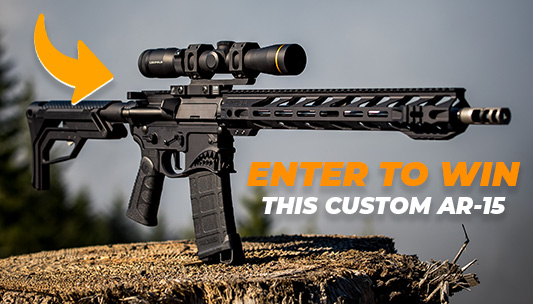Guns & Ammo
How Do Suppressors Work?
Published
1 year agoon
By
Mike Garman
How do suppressors work? Read on to find out more about the mechanics, physics, and makeup of firearm silencers plus regulation for carriers!
RELATED: How To Improve Your Shooting Experience With A Muzzle Brake
In this article:
- Suppressors 101
- The Basic (Federal) Rules for Suppressors and Silencers
- How Suppressors Really Work
- Suppressed Weapons
- Bottomline
How Do Suppressors Work? | The Science Behind Silencers
Suppressors 101
Suppressors 101: Point of Impact: Suppressed vs Unsuppressed Capture – Guns & Ammo https://t.co/ekvWs9Ze9q pic.twitter.com/yYvbtdZS4Y
— ArcanePrepper (@ArcanePrepper) August 5, 2017
Suppressors are covered by the National Firearms Act (NFA). This document defines what a silencer or suppressor is.
If you have never read any kind of federal rule such as the NFA, it will give you a headache, so I'll give you the gist.
Section 2.1.7 of the NFA defines a silencer as follows:
A firearm silencer and a firearm muffler are defined as any device for silencing, muffling, or diminishing the report of a portable firearm. Firearm silencers are generally composed of an outer tube, internal baffles, a front end cap, and a rear end cap.
The document goes on to say, “The definition of a silencer also includes any combination of parts, designed or redesigned, and intended for use in assembling or fabricating a firearm silencer or firearm muffler.”
This simply means that any piece or part you use to make or repair a suppressor is a suppressor you can control just like a full functioning suppressor.
At the federal level, anyone can own a suppressor if they meet the basic rules, fill out the forms, get the local Police Chief or Sheriff to sign off on it, and pay the $200 tax. However, many state suppressor laws do not allow an individual to own a suppressor (see below).
The Basic (Federal) Rules for Suppressors and Silencers
- Must be 21 years old when purchasing from a dealer
- Typically, if you can buy a handgun, you can buy a silencer
- Must have no convictions for a felony or pleaded guilty to domestic violence charge(s)
- Must be a United States Citizen
The following states allow civilian ownership of silencers:
- Alabama
- Alaska
- Arizona
- Arkansas
- Colorado
- Connecticut
- Florida
- Georgia
- Idaho
- Indiana
- Kentucky
- Louisiana
- Maine
- Maryland
- Massachusetts
- Montana
- Nebraska
- Nevada
- New Hampshire
- New Mexico
- North Carolina
- Ohio
- Oklahoma
- Oregon
- Pennsylvania
- South Carolina
- South Dakota
- Tennessee
- Texas
- Utah
- Vermont
- Virginia
- Washington (allows possession but not use)
- Wisconsin
- Wyoming
If your state isn't listed here, you will not be able to own a silencer.
Once a suppressor is transferred to you, you can’t loan it to a friend, and you can’t take it out of the state you live in unless you do the correct paperwork.
RELATED: Top Glock Mods To Consider For Glock Owners
How Suppressors Really Work
Muzzle Devices 101 — https://t.co/K270WIGAng — #muzzlebrake #flashhider #flashsuppressor #compensator #suppressor #muzzledevice #rifles pic.twitter.com/tvTqhZAC3Q
— American Rifleman (@NRA_Rifleman) February 13, 2017
To put it simply, a suppressor is a muffler for your firearm, and it works just like the muffler on your car.
A suppressor design redirects and slows down the high-pressure gas from firing the weapon. It is made out of just about anything, but it is usually a tube you attach to the barrel of a firearm.
This tube has holes in it to redirect the gas to a series of baffles or chambers. It then bleeds off the gases into the chambers and slows it down, thus reducing the sound of the shot.
The tube and baffles would be in an enclosure or “can”, which can be made out of high-tech materials like carbon fiber and titanium. Or, as low tech as a 2-liter soda bottle with some water in it.
You can purchase a suppressor from a Class III FFL for a couple of hundred dollars to several thousands of dollars, plus the $200 tax stamp.
As long as you follow the rules, you could make your own. But remember, once you do that, you open yourself up to inspections by the Bureau of Alcohol, Tobacco, Firearms, and Explosives.
And as mentioned above, any part of a suppressor is a suppressor.
What to Expect in Suppressors
One thing to keep in mind is a suppressor does not make firing a weapon completely silent. But it will reduce the sound's signature to the point where you don’t need earplugs and muffs.
Hearing protection is still a must for prolonged exposure. As an example, a .22LR makes about 160 dB.
With a good suppressor, you might be able to reduce that to about 120 dB. Besides the sound made by the explosion and expanding gas, the bullet itself will make noise as it goes supersonic.
Using sub-sonic ammunition will fix this problem, but keep in mind that in a semi-automatic, a sub-sonic round may not have enough energy to cycle the action.
Suppressed Weapons
Suppressors 101: Matching Suppressors to Sights https://t.co/PvHwR4UqlR Guns & Ammo #Adventure #Travel #micksgonebu… pic.twitter.com/AajCyW0Qh3
— Micks Gone Bush (@MicksGoneBush) August 22, 2017
Over the years, suppressors are subject in movies and television by good guys and bad guys. They come with all kinds of firearms using a closed bolt with the mechanics for suppression.
My definition of a closed bolt is a firearm where the firing chamber is sealed. This can be a semi-auto, single shot, bolt action, handgun, rifle, shotgun, or machine gun.
The Mosin Nagant M1895 Revolver
Contrary to what they show in older television shows and movies, a revolver cannot be fully suppressed. The gap between the cylinder and the barrel allows expanding gas to escape which defeats the purpose of a suppressor.
There is, however, one revolver that can be suppressed and that is the Mosin Nagant M1895 revolver. It has a 7.62×38mmR chamber and features a very unusual “gas-seal” system.
That is when the cylinder moves forward when you cock your gun, thus sealing the gap between the cylinder and the barrel. Among other things, this allows the weapon to be suppressed.
My research shows that this is the only mass-produced revolver that can be suppressed.
Bottomline
Assassins and spies with licenses to kill use suppressors. But, changing gun silencer laws around the county are making the use of a suppressor for hunting and target shooting more commonplace.
As their use becomes more accepted, the number of manufactures and the quality goes up while the price goes down.
Check out this video from SilencerCo on how a silencer is made, specifically the SILENCERCO SAKER 5.56:
How do suppressors work? It's probably the first question a lot of gun newbies ask. This is likely because suppressors or silencers are the stuff of movies and TV for so long.
Because of that, there are a lot of misconceptions about what a suppressor is, the legalities of owning one, and the science behind them. This article should clear all that up and we hope it gave you a solid background in suppressor tech and application.
Have you tried using suppressors before? How was your experience? Share them in the comment section below!
Up Next:
- DIY Threading Barrels For Muzzle Brakes And Suppressors
- Visualization Techniques Will Make You A Better Shooter
- 5 Pistol Modifications You Need To Avoid | Gun Carrier
**Disclaimer: All content on this site is for informational purposes only. Please read our full disclaimer**

Editor’s Note: This post was originally published on March 23, 2015, and has been updated for quality and relevancy.

Staccato P Review | Staccato P 1000 Round – The Most Accurate Duty Pistol

Sawed Off Shotgun | Everything You Need To Know

CZ 75 SP01 Tactical Gun Review | Gun Carrier

PODCAST: Gun Law Changes All Across America Right Now

PODCAST: How to Win Olympic Gold

PODCAST: 50 Important Ideas For Self-Defense, Self-Reliance, and Personal Safety



James Peters
June 7, 2017 at 7:59 AM
I noticed Missouri is not on your list but they are now legal here if one is willing to go through the the process of getting the NFA Tax Stamp
Greg
July 10, 2016 at 3:40 AM
Suppressors are also now legal in Kansas.
Kitty
May 23, 2016 at 4:03 AM
We’re the manufacturer of carbon fiber suppressor tube in China for many years,with good quality and attractive price.
Light-weight , high strength and anti-corrosion are the main features of carbon fiber tube.
Hope to cooperate with you in the future.
Best regards,
Kitty